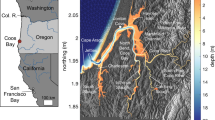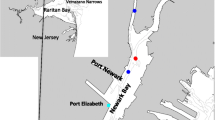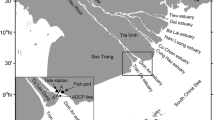Abstract
We investigate the evolution of the salt field in a bar-built estuary after the tidal inlet is closed by sediment, isolating the estuary from the ocean. We show that seawater trapped by inlet closure in the Russian River Estuary, CA, undergoes a two-stage landward intrusion process that leads to widespread salt stratification throughout the estuary. This salinity intrusion extends to distances of several kilometers from the beach—into the “inner estuary” that is separated from the “outer estuary” by shallow sills and typically devoid of saline waters during tidal conditions when the mouth is open. We describe landward movement of saline waters during six closure events in 2009 and 2010, based on repeat boat-based conductivity-temperature-depth (CTD) surveys and bottom-mounted acoustic Doppler current profilers (ADCPs). While sills block the initial landward motion of dense saline waters due to gravitational adjustment (first stage of intrusion), these same sills facilitate a wind-induced, one-direction valve mechanism through which saline waters are pumped into the inner estuary. Saline waters that crest the shallow sill can drain into deeper pools in the inner estuary as a pulsed gravity current (second stage of intrusion). We use empirical orthogonal function (EOF) analysis to identify an internal seiche in the outer estuary that results in uplift of pycnocline waters during the night at the boundary to the inner estuary. EOF analysis of inner estuary currents and a horizontal Richardson number are used to suggest that nocturnal gravity current events in the inner estuary (beyond the blocking sill) occur as pulses initiated by the internal seiche in the outer estuary.















Similar content being viewed by others
References
Antenucci J.P., J. Imberger, and A. Saggio. 2001. Seasonal evolution of the basin-scale internal wave field in a large stratified lake. Limnology and Oceanography 45(7): 1621–1638.
Arita M., and G.H. Jirka. 1987. Two-layer model of saline wedge. I: Entrainment and interfacial friction. Journal of Hydraulic Engineering 113(10): 1229–1246.
Behrens D.K., F.A. Bombardelli, J.L. Largier, and E. Twohy. 2009. Characterization of time and spatial scales of a migrating rivermouth. Geophysical Research Letters 36: L09402. doi:10.1029/2008GL037025.
Behrens D.K. 2012. The Russian River Estuary: inlet morphology, management, and estuarine scalar response. PhD dissertation: Department of Civil and Environmental Engineering, University of California, Davis.
Behrens D.K., F.A. Bombardelli, J.L. Largier, and E. Twohy. 2013. Episodic closure of the tidal inlet at the mouth of the Russian river—a small bar-built estuary in California. Geomorphology 189: 66–80. doi:10.1016/j.geomorph.2013.01.017.
Bombardelli F.A., M.I. Cantero, M.H. García, and G.C. Buscaglia. 2009. Numerical aspects of the simulation of discontinuous saline underflows: the lock-exchange problem. Journal of Hydraulic Research 47(6): 777–789.
Cooper J.A.G. 2001. Geomorphological variability among microtidal estuaries from the wave-dominated South African coast. Geomorphology 40: 99–122.
Cousins M., M. Stacey, and J. Drake. 2010. Effects of seasonal stratification on turbulent mixing in a hypereutrophic coastal lagoon. Limnology and Oceanography 55: 172–186.
Emery W.J., and R.E. Thomson. 2004. Data analysis methods in physical oceanography, 2nd edn. Amsterdam: Elsevier.
Environmental Data Solutions (EDS), 2009. Unpublished sidescan sonar bathymetry data and LiDAR topography data for the Russian River from the mouth to Duncan Mills. Environmental Data Solutions, conducted for Sonoma County Water Agency.
Fischer H., J. List, R. Koh, J. Imberger, and N. Brooks. 1979. Mixing in inland and coastal waters. London: Academic Press.
Gale E., C. Pattiaratchi, and R. Ranasinghe. 2006. Vertical mixing processes in intermittently closed and open lakes and lagoons, and the dissolved oxygen response. Estuarine, Coastal and Shelf Science 69: 205–216. doi:10.1016/j.ecss.2006.04.013.
Giddings S.N., D. Fong, S. Monismith, C. Chickadel, K. Edwards, W. Plant, B. Wang, O. Fringer, A. Horner-Devine, and A. Jessup. 2012. Frontogenesis and frontal progression of a trapping-generated estuarine convergence front and its influence on mixing and stratification. Estuaries and Coasts 35: 665–681. doi:10.1007/s12237-011-9453-z.
Gill A.E. 1982. Atmosphere-ocean dynamics. Academic Press.
Hayes S., M. Bond, C. Hanson, E. Freund, J. Smith, E. Anderson, A. Ammann, and B. MacFarlane. 2008. Steelhead growth in a small central California watershed: upstream and estuarine rearing patterns. Transactions of the American Fisheries Society 137: 114–128. doi:10.1577/T07-043.1.
Imberger J., and G. Parker. 1985. Mixed layer dynamics in a lake exposed to a spatially variable wind field. Limnology and Oceanography 30(3): 473–488.
Jassby A.D., W.J. Kimmerer, S.G. Monismith, C. Armor, J.E. Cloern, J.R. Schubel, and T.J. Vendlinski. 1995. Isohaline position as a habitat indicator for estuarine populations. Ecological Applications 5(1): 272–289.
Kraus N., S. Munger, and K. Patsch. 2008. Barrier beach breaching from the lagoon side, with reference to northern California. Shore and Beach 76: 33–43.
Kundu P.K., I.M. Cohen, and D.R. Dowling. 2012. Fluid mechanics, 5th edn. Oxford: Elsevier.
Largier J.L. 1986. Structure and mixing in the Palmiet Estuary, South Africa. South African Journal of Marine Science 4: 139–152.
Largier J.L., H. Slinger, and S. Taljaard. 1991. The stratified hydrodynamics of the Palmiet—a prototypical bar-built estuary. In Dynamics and exchanges in estuaries and coastal seas, ed. D. Prandle. New York: Springer-Verlag.
Largier J.L. 1992. Tidal intrusion fronts. Estuaries 15: 26–39.
LaZerte B.D. 1980. The dominating higher order vertical modes of the internal seiche in a small lake. Limnology and Oceanography 25(5): 846–854.
Linden P.F., and J.E. Simpson. 1986. Gravity-driven flows in a turbulent fluid. Journal of Fluid Mechanics 172: 481–497.
Linden P.F., and J.E. Simpson. 1988. Modulated mixing and frontogenesis in shallow seas and estuaries. Continental Shelf Research 8(10): 1107–1127.
MacCready P., and W.R. Geyer. 2010. Advances in estuarine physics. Annual Reviews in Marine Science 2(1): 35–58. doi:10.1146/annurev-marine-120308-081015.
Monismith S.G. 1985. Wind-forced motions in stratified lakes and their effect on mixed-layer shear. Limnology and Oceanography 30(4): 771–783.
Monismith S.G., W. Kimmerer, J.R. Burau, and M.T. Stacey. 2002. Structure and flow-induced variability of the subtidal salinity field in northern San Francisco Bay. Journal of Physical Oceanography 32: 3003–3019.
Münnich M., A. Wuest, and D.M. Imboden. 1992. Observations of the second vertical mode of the internal seiche in an alpine lake. Limnology and Oceanography 37(8): 1705–1719.
Nelson B.W., A. Sasekumar, and Z.Z. Ibrahim. 1994. Neap-spring tidal effects on dissolved oxygen in two Malaysian estuaries. Hydrobiologia 285: 7–17.
O’Callahan J., C. Pattiaratchi, and D. Hamilton. 2007. The response of circulation and salinity in a micro-tidal estuary to sub-tidal oscillations in coastal sea surface elevation. Continental Shelf Research 27: 1947–1965. doi:10.1016/j.csr.2007.04.004.
Officer C.B. 1976. Physical oceanography of estuaries. New York: Wiley & Sons.
Okely P., and J. Imberger. 2007. Horizontal transport induced by upwelling in a canyon-shaped reservoir. Hydrobiologia 586: 343–355. doi:10.1007/s10750-007-0706-6.
Pritchard D.W. 1967. What is an estuary: physical viewpoint. Estuaries 83: 3–5.
Ranasinghe R., and C. Pattiaratchi. 2003. The seasonal closure of tidal inlets: causes and effects. Coastal Engineering 45(4): 601–627.
Roy P.S., R.J. Williams, A.R. Jones, I. Yassini, P.J. Gibbs, B. Coates, R.J. West, P.R. Scanes, J.P. Hudson, and S. Nichol. 2001. Structure and function of south-east Australian estuaries. Estuarine, Coastal and Shelf Science 53: 351–384. doi:10.1006/ecss.2001.0796.
Sharples J., M. Coates, and J. Sherwood. 2003. Quantifying turbulent mixing and oxygen fluxes in a Mediterranean-type, microtidal estuary. Ocean Dynamics 53: 126–136.
Shintani T., A. de la Fuente, Y. Niño, and J. Imberger. 2010. Generalizations of the Wedderburn number: parameterizing upwelling in stratified lakes. Limnology and Oceanography 55(3): 1377–1389. doi:10.4319/lo.2010.55.3.1377.
Slinger J.H., and J.L. Largier. 1990. The evolution of thermohaline structure in a closed estuary. Southern African Journal of Aquatic Sciences 16: 60–77.
Stacey M.T., S.G. Monismith, and J.R. Burau. 1999. Measurements of Reynolds stress profiles in unstratified tidal flow. Journal of Geophysical Research 104(C5): 10,933–10,949.
Stacey M.T., J.R. Burau, and S.G. Monismith. 2001. Creation of residual flows in a partially stratified estuary. Journal of Geophysical Research 106(C8): 17,013–17,037.
Stacey, M.T., T.P. Rippeth, and J.D. Nash. 2011. Turbulence and stratification in estuaries and coastal seas. In Earth systems and environmental science, Ch. 2: Treatise on estuarine and coastal science, ed. Wolanksi and McLusky. San Diego: Elsevier.
Taljaard, S., and J.L. Largier. 1989. Water circulation and nutrient distribution patterns in the Palmiet River estuary: a winter study. CSIR Research Report No. 680, Stellenbosch, CSIR.
U.S. Army Corps of Engineers (USACE). 2008. Coastal engineering manual. Part 2, Chapter 2, Meteorology and Wave Climate. July 2003.
Vidal J., and X. Casamitjana. 2008. Forced resonant oscillations as a response to periodic winds in a stratified reservoir. Journal of Hydraulic Engineering 134(4): 416–425. doi:10.1061/(ASCE)0733-9429(2008)134:4(416).
Vlasenko V.I., and K. Hutter. 2002. Transformation and disintegration of strongly nonlinear internal waves by topography in stratified lakes. Annales Geophysicae 20: 2087–2103.
Wiegand R.C., and V. Chamberlain. 1987. Internal waves of the second vertical mode in a stratified lake. Limnology and Oceanography 32(1): 29–42.
Williams E., and J.H. Simpson. 2004. Uncertainties in estimates of Reynolds stress and TKE production rate using the ADCP variance method. Journal of Atmospheric and Oceanic Technology 21: 347–357.
Acknowledgments
This project was funded by the Sonoma County Water Agency (SCWA). We thank Jeff Church of SCWA for providing sonde data, Steven Morgan for use of his boat, Elinor Twohy for the accommodation at the study site, Matt Brennan for the discussions about estuary processes, and Anthony Collins for the help with figure design. We also thank Gabriel Miller-Mesner, Tammer Barkouki, David Dann, Matt Robart, Henry Fastenau, and other BML staff for their help with diving and other field/analysis support.
Author information
Authors and Affiliations
Corresponding author
Additional information
Communicated by Carl T. Friedrichs
Rights and permissions
About this article
Cite this article
Behrens, D.K., Bombardelli, F.A. & Largier, J.L. Landward Propagation of Saline Waters Following Closure of a Bar-Built Estuary: Russian River (California, USA). Estuaries and Coasts 39, 621–638 (2016). https://doi.org/10.1007/s12237-015-0030-8
Received:
Revised:
Accepted:
Published:
Issue Date:
DOI: https://doi.org/10.1007/s12237-015-0030-8




